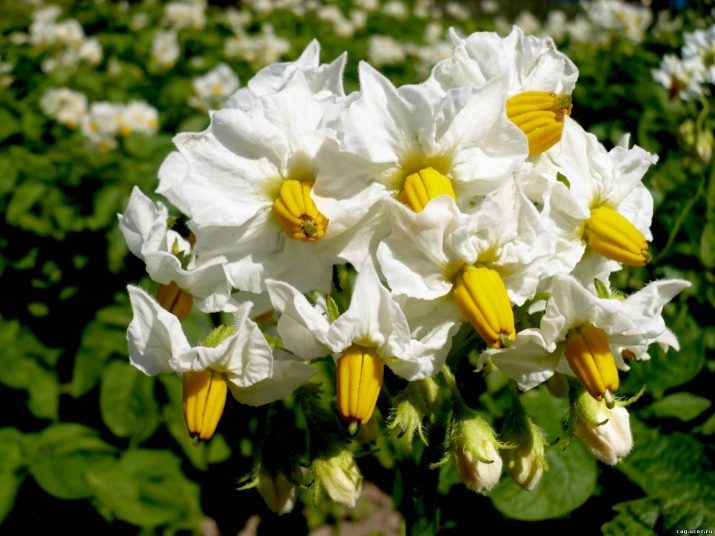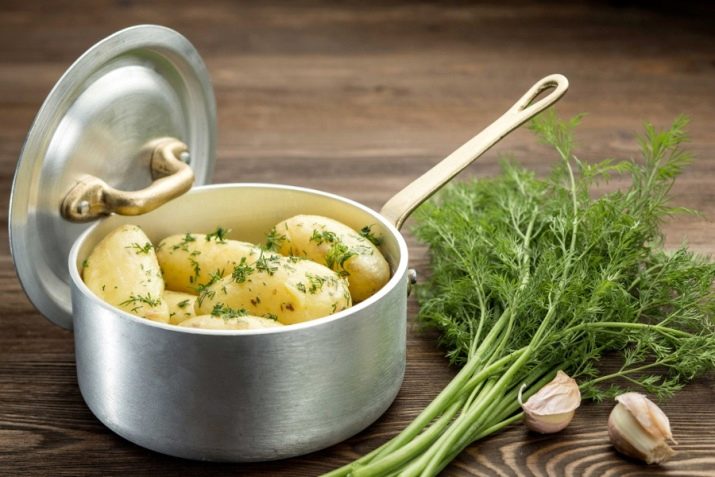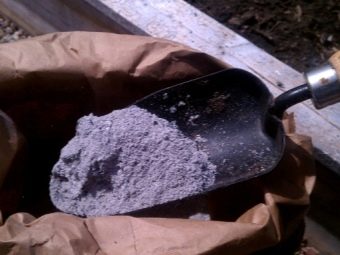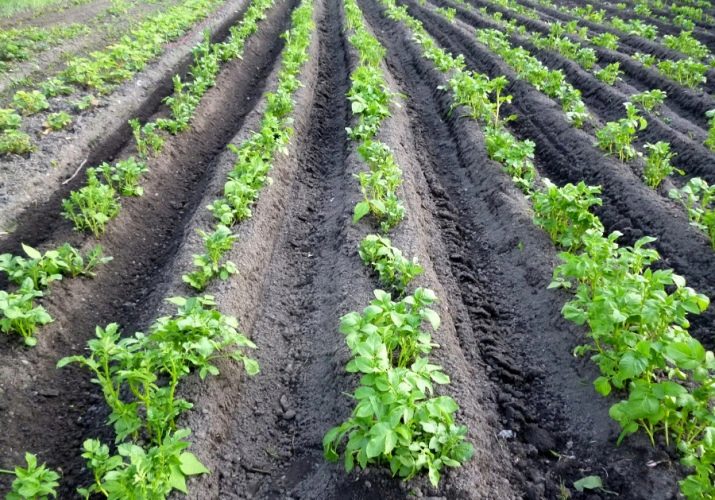Potatoes "Giant": variety description and cultivation

For several centuries, potatoes have been one of the main crops used in nutrition.But breeders do not stop working on the improvement of the usual root, even in the XXI century. One of the latest domestic developments - the potato "Velikan" - certainly deserves attention from farmers and large farms.
Special features
This variety was obtained in the VNII. Lorch. According to the recommendations of the breeding group, it is intended for the center of the European part, for the Central Black Soil Region and for the Volga-Vyatka region.
Potato is classified as mid-season, can be used not only for culinary purposes, but also as a raw material for the production of starch.
The basic lines of culture at work were "946-3", "Effect". The description of the variety with the indication of its main parameters is entered in the national register in 2013.
On the field "Giant" stands out for its height. Flowers it with small or medium corolla. The foliage is large, it belongs to the intermediate category and is colored dark green. Tubers have a transitional form from oval to circle, color is light beige, eyes are deposited at moderate depth. The weight of one tuber does not exceed 0.145 kg. On the cut potatoes are white with a cream tinge. The maximum concentration of starch is slightly less than 19%. From 1 ha you can get up to 424 centners of yield, the conservation coefficient (keeping quality) is 97%.
Positive sides
The attractive characteristics of the "Giant" are:
- large and stable yield;
- the ability of tubers to maintain quality after prolonged storage;
- stable coloring of soft tissues (does not darken in the air);
- excellent immunity against viruses;
- ability to survive with strong warming and even with drought;
- low probability of damage to potato cancer;
- limited protection from common scab, late blight and rhizoctoniosis;
- excellent culinary properties.
It should not be forgotten that the "Giant" easily becomes infected with a potato nematode.
How to plant and care
Positive feedback on the variety does not mean that it can be cultivated thoughtlessly and in any conditions. For planting potatoes, it is recommended to use flat areas with fertile soil.
Intensive lighting and protection from groundwater stagnation are very important.
If acidic soil is present, chalking is organized or 20 kg of gypsum is added for every 0.01 ha. Agronomists also attach great importance to the formation of straight rows, preserving the original value of the rows between rows.
When planting the "Giant" in the spring, it can be supported by introducing into the ground:
- peat;
- ash;
- soil with humus.
But this is not the best option. The highest results are achieved with the advance (autumn) saturation of the soil. At this moment, in addition to the main treatment, organic fertilizers and green manure are used. From organic matter, sustained manure from litter is recommended (on average 500 kg per 1 hundred square meters). It is also a good idea to use compositions based on potassium and phosphorus (3 kg each for the same area).
It is possible to increase the yield of potatoes of this variety, as in other cases, by using specially selected inoculum, which is additionally treated with fungicides and growth promoters. Hilling assists strictly in technology. It solves four problems at once:
- release from weeds;
- replacement and loosening of the soil around the landings;
- optimization of conditions for tuber ripening;
- support of a plant at excessively high air temperature.
A very important role is played by the watering of the “Giant” in the strictly allotted time. If moisture is not enough, the death of stolons and a reduction in yield are likely. The result achieved with the introduction of fertilizers is determined by soil parameters, climate and quality of agricultural technology. Manure has a positive effect on all soils, but its effect is best on podzolic turf, on sand and sandy loam.
For protection against pests and diseases, spraying mixtures are recommended:
- Kinmiks;
- "Tsimbush";
- Ditan M-45;
- "Sandofan M8";
- Kuproksat.
Additional information and reviews
Potato "Giant" has already managed to establish itself well among gardeners. He gives a harvest for 80 - 100 days after planting, while the bush accounts for 8 to 13 fruits. The rind, like the flesh, is colored cream. The number of leaves is not too large. The roots are developed quite well. The degeneration of seed has not yet been fixed.
The stagnant water in the ground has a negative effect on the plant, and it also does not tolerate heavy loams.
It is best to plant the potatoes after the siderats: oil radish, lupine and fatsely. Of the main crops, cabbage, peas, beans, carrots and beans are considered good predecessors.
Only tubers with a flat external line are selected for planting, medium in size. The display of light for germination is done exactly 1 month before disembarking. Experts do not recommend splitting (cutting) “Giant” tubers planted. Among them is to choose those that have the strongest and longest sprouts.
Excessive introduction of nitrogen-containing fertilizers into the soil is unacceptable. It is recommended, in addition to starting feeding, to do another - against the background of flowering bushes. Top-dressing outside the roots (spraying the foliage with superphosphate in dissolved form) is done about 10 days before harvesting.
A limited amount of moisture is experienced by planting normally, only sustained dry time brings harm. Against the background of a sultry dry summer, it is worthwhile to apply sprinkling or resort to drip irrigation. Hilling is done at least twice per season.
The “Giant” has a relative immunity to viruses of striped and wrinkled mosaic. Leaf folding is unlikely.
The main danger among pests other than the Colorado potato beetle is wireworm, medvedki and potato moth. It is recommended to farm the soil before planting and collect the beetles from the plants manually. The use of synthetic or natural remedies is strictly for the choice of the gardener and in accordance with the effectiveness.
When there are 7 days left before fruit picking, the tops are cut from the bushes. Then the tubers will be larger and more useful.
The taste of the fruit is quite satisfying for most people. Tubers are not prone to cooking, on the contrary, they acquire tenderness and friability when cooking. During the cutting sections do not darken. Fruits can be stewed, stuffed and baked.
In general, the potato variety “Velikan” may be recommended for cultivation by farmers and ordinary gardeners.
A good harvest of potatoes is a real joy for any summer resident. Some tricks experienced gardeners, gardeners will save longer such a root.



























